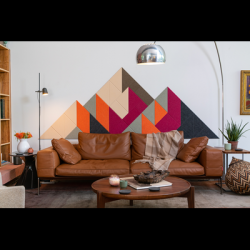The use of typography as a dynamic, expressive element is particularly noteworthy. Letterforms were manipulated into wave-like shapes, almost becoming part of the visual narrative themselves. In this sense, the design was not merely illustrative but participatory, requiring the viewer to slow down and engage with the image actively, mirroring the attentive listening experience encouraged by psychedelic music.
The Transformation of Album Art
Before the 1960s, album covers were largely utilitarian: simple portraits, basic typography, or minimalist graphics. The rise of the counterculture and the explosion of rock music catalyzed a revolution in design. Album covers became a canvas to express musical, social, and philosophical ideas.
Peter Blake and Jann Haworth’s work on The Beatles’ Sgt. Pepper's Lonely Hearts Club Band (1967) is emblematic: a collage of historical and contemporary figures, surreal imagery, and vibrant colors that mirrors the album’s experimental sound. Every element conveyed layers of meaning, reflecting not just the music but the zeitgeist of the era (uDiscover Music, 2025).
Designers like Andy Warhol (The Velvet Underground & Nico), Hipgnosis (Pink Floyd, Led Zeppelin), and Storm Thorgerson pushed album art into conceptual territory. Covers were no longer just marketing tools—they were autonomous works of art, capable of conveying narrative, mood, and cultural critique. For example, Hipgnosis’ use of photography and surreal composition created imagery that could be interpreted metaphorically, thematically, and symbolically, blurring the line between music packaging and fine art (Bellwether Digest, 2025).
Album art also played a role in identity formation. Fans used these visual cues to align themselves with subcultures, ideas, and aesthetics, making the artwork an integral part of the social experience of music.
Psychedelic Music: Beyond the Genre Label
Psychedelic music of the mid-1960s was less a rigid genre than a set of exploratory approaches to sound and consciousness. Bands like The Grateful Dead, Jefferson Airplane, The Doors, and Pink Floyd experimented with extended improvisation, unusual time signatures, modal scales, exotic instrumentation, and studio effects designed to evoke altered states of awareness (Wikipedia, 2025).
Lyrics explored perception, dreams, inner journeys, and social commentary, often blending literary and philosophical references with personal reflection. Psychedelia allowed musicians to expand the sonic palette and push technical boundaries, integrating technology—like tape loops, reverb, and multi-tracking—as an expressive tool. It was a period in which experimentation itself became a cultural statement.
Notably, the “psychedelic” label often reflected cultural positioning more than consistent musical practice. Some bands were branded as psychedelic by association with certain venues, art scenes, or audiences, highlighting the term’s sociocultural dimension as much as its musical one (MasterClass, 2025).
Album Art Timeline: Evolution and Highlights
| Decade | Key Developments in Album Art |
|---|---|
| 1950s | Functional, minimalist designs; photographic portraits dominated; album art primarily utilitarian. |
| 1960s | Introduction of artistic and psychedelic influences; posters and covers reflect counterculture and experimentation. |
| 1970s | Conceptual designs and thematic cohesion; elaborate photography and illustration; rise of concept albums. |
| 1980s | Digital art emerges; branding and identity emphasized; MTV influences visual design. |
| 1990s | Minimalist and symbolic trends; typography plays a larger role; independent labels foster creative freedom. |
| 2000s | Digital distribution changes design priorities; abstract, experimental, and collage-style covers proliferate. |
| 2010s | Vinyl resurgence promotes high-concept, large-scale cover art; integration with digital visuals and online branding. |
Iconic Visual Examples
- The Beatles – Sgt. Pepper's Lonely Hearts Club Band (1967): A vivid collage representing musical and social experimentation.
- Pink Floyd – The Dark Side of the Moon (1973): Minimalist prism design reflecting conceptual depth and sonic clarity; became an enduring cultural symbol.
- David Bowie – Ziggy Stardust (1972): Glam rock theatrics and surreal imagery merge persona, music, and visual storytelling.
- The Doors – Strange Days (1967): Illustrations and photography combine urban and dreamlike motifs to echo lyrical themes.
- Jimi Hendrix – Axis: Bold as Love (1967): Psychedelic portraiture and vivid color convey experimentalism and musical intensity.
- Grateful Dead – Aoxomoxoa (1969): Complex, colorful illustrations blending fantasy and countercultural symbolism.
- Frank Zappa – Hot Rats (1969): Surreal photography and design reflecting jazz-rock fusion and avant-garde experimentation.
The Psychedelic Aesthetic Beyond Music
Psychedelic influences permeated fashion, interior design, literature, and film. Bold patterns, kaleidoscopic colors, and flowing silhouettes became cultural signifiers. Films like Yellow Submarine (1968) and visual works by filmmakers such as Kenneth Anger integrated psychedelic sensibilities into narrative and technique, emphasizing color, motion, and dream logic over linear storytelling.
In literature, writers such as Aldous Huxley and Timothy Leary explored consciousness, perception, and human potential, providing intellectual frameworks that influenced both visual artists and musicians. The aesthetic’s interdisciplinary nature underscores its role as a cultural movement rather than a passing stylistic trend.
Conclusion
The psychedelic aesthetic was far more than a byproduct of drug culture—it represented an era of experimentation, artistic innovation, and cultural questioning. Concert posters, album art, and music became instruments of expression and communication, translating experiences into visual and auditory forms that could inspire, challenge, and captivate audiences. Its influence persists in contemporary design, music, and media, proving that psychedelic art was a transformative movement, redefining the relationship between perception, creativity, and culture.
Works Cited
- Visual Arts Department. "Psychedelic 60s - Graphic Design History." 2025.
- ARTpublika Magazine. "Exploring 1960s Concert Posters and the Artists Behind Them." 2025.
- uDiscover Music. "Cover Story: A History Of Album Artwork." 2025.
- Bellwether Digest. "The Evolution of Album Art." 2025.
- Wikipedia. "Psychedelic Music." 2025.
- MasterClass. "Psychedelic Rock: The History and Sound of Psychedelic Rock." 2025.
- Anger, Kenneth. Hollywood Babylon. 1965.
- Leary, Timothy. The Psychedelic Experience. 1964.
Explore further:
- Join the Discussion in the Forum
- Dive into the Annotated Timeline of Rock History
- Learn More in the Rock Bible
Image Credit: Freepik.com




